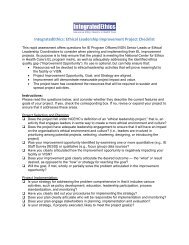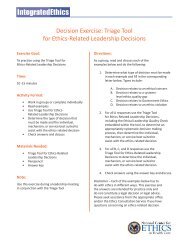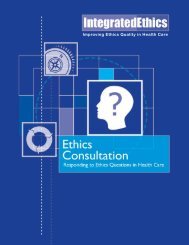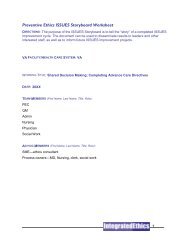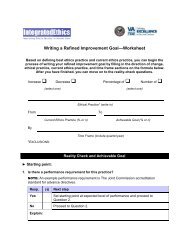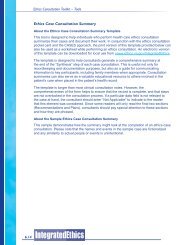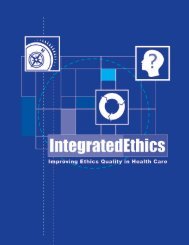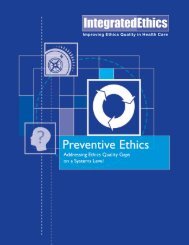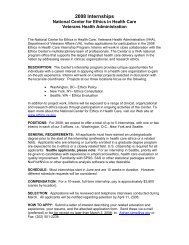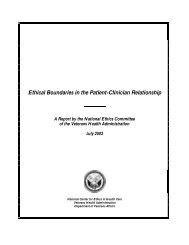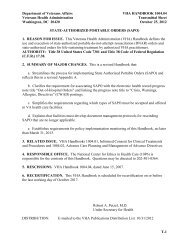Part III: The <strong>Ethical</strong> <strong>Leadership</strong> CompassHealthcare executives have a responsibility to address the growing number ofcomplex ethical dilemmas they are facing, but they c<strong>an</strong>not <strong>an</strong>d should not makesuch decisions alone or without a sound decision-making framework. Healthcareorg<strong>an</strong>izations should have vehicles . . . to assist healthcare executives with thedecision-making process. With these org<strong>an</strong>izational mech<strong>an</strong>isms, the sometimesconflicting interests of patients, families, caregivers, the org<strong>an</strong>ization, payors, <strong>an</strong>dthe community c<strong>an</strong> be appropriately weighed <strong>an</strong>d bal<strong>an</strong>ced.[72]The literature on leadership <strong>an</strong>d m<strong>an</strong>agement offers a wide variety of models for ethicaldecision making to assist leaders in thinking through complex ethical considerationseither by themselves or in collaboration with others. (Examples of decision-makingmodels are available on the Center’s website, vaww.ethics.va.gov/IntegratedEthics.or www.ethics.va.gov/IntegratedEthics) We don’t recommend <strong>an</strong>y single model, sincedifferent models suit different situations <strong>an</strong>d leadership styles.The models differ in their details, but in one way or <strong>an</strong>other they are all intended to leadto decisions that share the following attributes:Informed. The more value-laden a decision is or the more it involves uncertaintyabout what is the right course of action, the more import<strong>an</strong>t it is that it be wellinformed. Leaders must ensure not only that they have collected the full r<strong>an</strong>ge offacts that bear on a given decision but also that they underst<strong>an</strong>d the perspectivesof those who are (or should be) involved in making the decision <strong>an</strong>d those whowill be affected by it.Participatory. To the extent possible, individuals who have a stake in theoutcome should be allowed to have input into the decision-making process. Thisnot only generates buy in, it provides useful insights <strong>an</strong>d demonstrates respect forthose who will be affected by the decision.Values-based. By values, we me<strong>an</strong> strongly held beliefs, ideals, principles, orst<strong>an</strong>dards that inform ethical decisions or actions. Well-made decisions weighoptions carefully in relation to import<strong>an</strong>t org<strong>an</strong>izational <strong>an</strong>d social values. Thisrequires that the values at stake in a decision, such as fairness, stewardship, orfidelity to mission, be clarified <strong>an</strong>d explicitly considered.Values-Based Decision MakingTo make values-based decisions, leaders must be familiar with various typesof ethics-related resource materials <strong>an</strong>d use them to inform their decisions.Sources of information on values in health care include org<strong>an</strong>izational mission<strong>an</strong>d values, statements of ethical principles, professional codes of conduct,<strong>an</strong>d org<strong>an</strong>ization <strong>an</strong>d public policies. (See “Tools for <strong>Ethical</strong> <strong>Leadership</strong>” forexamples.)In some inst<strong>an</strong>ces, weighing options in relation to values may be a relativelystraightforward task; in others, however, it may call for close ethical <strong>an</strong>alysis.Since ethical <strong>an</strong>alysis requires specialized knowledge <strong>an</strong>d skills, leaders willoften find it useful to have access to experienced <strong>an</strong>d trusted experts they c<strong>an</strong>involve or consult through their local ethics program.33
Part III: The <strong>Ethical</strong> <strong>Leadership</strong> CompassBeneficial. <strong>Ethical</strong> decision making requires that leaders weigh the short- <strong>an</strong>d longtermconsequences, both positive <strong>an</strong>d negative, <strong>an</strong>d make sure that the benefitsof the decision outweigh potential harms. Making those determinations involvesbal<strong>an</strong>cing fairly the different interests of stakeholders, including patients, staff, theorg<strong>an</strong>ization, <strong>an</strong>d, often, the community. Leaders may find it helpful to consider bestcase<strong>an</strong>d worst case scenarios as a way of thinking about the impact a decision willhave on different parties or different activities across the org<strong>an</strong>ization.Systems-focused. <strong>Ethical</strong> decision making should include <strong>an</strong> examination ofunderlying systems issues that may cause or contribute to ethical concerns. Ideally,the decision should prevent similar situations from happening again. Focusing onsystems issues c<strong>an</strong> also help to ensure that the decision establishes a precedentthat c<strong>an</strong> be applied to other similar cases.Reasonable. Finally, leaders should consider how their decisions will be perceivedby persons other th<strong>an</strong> those directly involved in the decision-making process orimmediately affected by a given decision itself. Imagining whether a decision wouldseem reasonable to a friend or family member or to a mentor or respected colleagueoutside the org<strong>an</strong>ization c<strong>an</strong> be a useful exercise. Asking, “Would I be able todefend this decision to patients, external stakeholders, the media, or the generalpublic?” c<strong>an</strong> be <strong>an</strong>other test to help ensure that decisions rest on a defensibledecision-making process <strong>an</strong>d sound reasoning <strong>an</strong>d that they’ve been carefullyconsidered from all <strong>an</strong>gles <strong>an</strong>d is ethically justifiable.Quality CheckTo check the quality of your ethical decision-making process in relation to thedesired attributes, ask yourself these questions.•Do I have all the import<strong>an</strong>t facts relev<strong>an</strong>t to the decision?•Have I involved everyone who should be part of this decision?•Does this decision reflect org<strong>an</strong>izational, professional, <strong>an</strong>d socialvalues?•Do the likely benefits of the decision outweigh <strong>an</strong>y potential harms?•Will this decision keep the problem from recurring or establish a goodprecedent?•How would this decision look to someone outside the org<strong>an</strong>ization?34



